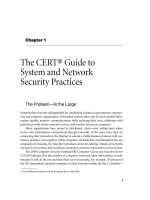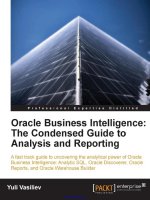IT training executive guide to apache and hadoop khotailieu
Bạn đang xem bản rút gọn của tài liệu. Xem và tải ngay bản đầy đủ của tài liệu tại đây (5.39 MB, 33 trang )
The Executive's Guide To
BIG DATA
& APACHE HADOOP
Everything you need to understand and
get started with Big Data and Hadoop
Robert D. Schneider
Author of Hadoop for Dummies
Executive’s Guide to Big Data & Apache Hadoop
The Executive's Guide To
BIG DATA & APACHE HADOOP
Introduction................................................................................................................. 4
Introducing Big Data................................................................................................... 4
What Turns Plain Old Data into Big Data?........................................................... 5
Larger Amounts of Information..................................................................... 5
Comparing Database Sizes................................................................. 6
More Types of Data...................................................................................... 8
Relational........................................................................................... 10
Columnar............................................................................................ 10
Key/Value........................................................................................... 10
Documents, Files, and Objects.......................................................... 10
Graph................................................................................................. 10
Generated by More Sources.......................................................................11
Retained for Longer Periods....................................................................... 12
Utilized by More Types of Applications....................................................... 12
Implications of Not Handling Big Data Properly.................................................. 13
Checklist: How to Tell When Big Data Has Arrived..................................... 14
Distributed Processing Methodologies..................................................................... 15
Hadoop..................................................................................................................... 18
Checklist: Ten Things to Look for When Evaluating Hadoop Technology........... 24
Hadoop Distribution Comparison Chart.................................................................... 27
Glossary of Terms..................................................................................................... 28
About the Author....................................................................................................... 32
Executive’s Guide to Big Data & Apache Hadoop
3
Introduction
It seems that everywhere you look – in both the mainstream press as well as in
technology media – you see stories or news reports extolling Big Data and its
revolutionary potential. But dig a little deeper, and you’ll discover that there’s great
confusion about Big Data in terms of exactly what it is, how to work with it, and how
you can use it to improve your business.
In this book, I introduce you to Big Data, describing what it consists of and what’s
driving its remarkable momentum. I also explain how distributed, parallel processing
methodologies – brought to life in technologies such as Hadoop and its thriving
ecosystem – can help harvest knowledge from the enormous volumes of raw data
– both structured and unstructured – that so many enterprises are generating today.
In addition, I point out that this is a highly dynamic field, with nonstop innovation that
goes far beyond the original batch processing scenarios to innovative new use cases
like streaming, real-time analysis, and pairing machine learning with SQL.
Finally, I provide some benchmarks that you can use to confirm that Big Data has
indeed arrived in your organization, along with some suggestions about how to
proceed.
The intended audience for this book includes executives, IT leaders, line-of-business
managers, and business analysts.
Introducing Big Data
Big Data has the potential to transform the way you run your organization. When
used properly it will create new insights and more effective ways of doing business,
such as:
How you design and deliver your products to the market
How your customers find and interact with you
Your competitive strengths and weaknesses
Procedures you can put to work to boost the bottom line
Executive’s Guide to Big Data & Apache Hadoop
4
What’s even more compelling is that if you have the right technology infrastructure
in place, many of these insights can be delivered in real-time. Furthermore, this
newfound knowledge isn’t just academic: you can apply what you learn to improve
daily operations.
What Turns Plain Old Data into Big Data?
It can be difficult to determine when you’ve crossed the nebulous border between
normal data operations and the realm of Big Data. This is particularly tough since Big
Data is often in the eye of the beholder. Ask ten people about what Big Data is, and
you’ll get ten different answers.
From my perspective, organizations that are actively working with Big Data have
each of the following five traits in comparison to those who don’t:
Larger amounts of information
More types of data
Data that’s generated by more sources
4 Data that’s retained for longer periods
5 Data that’s utilized by more types of applications
Let’s examine the implications of each of these Big Data properties.
Larger Amounts of Information
Thanks to existing applications, as well as new sources that I’ll soon describe,
enterprises are capturing, storing, managing, and using more data than ever before.
Generally, these events aren’t confined to a single organization; they’re happening
everywhere:
On average over 500 million Tweets occur every day
World-wide there are over 1.1 million credit card transactions every second
There are almost 40,000 ad auctions per second on Google AdWords
On average 4.5 billion “likes” occur on Facebook every day
Executive’s Guide to Big Data & Apache Hadoop
5
Let’s take a look at the differences between common sizes of databases.
Comparing Database Sizes
It’s easy to fall into the trap of flippantly tossing around terms like gigabytes,
terabytes, and petabytes without truly considering the truly impressive differences
in scale among these vastly different volumes of information. Table 1 below
summarizes the traits of a 1-gigabyte, 1-terabyte, and 1-petabyte database.
Database Size
Common Characteristics
Information generated by traditional enterprise
applications
1 gigabyte
Typically consists of transactional data, stored in
relational databases
Uses Structured Query Language (SQL) as the
access method
Standard size for data warehouses
1 terabyte
Often aggregated from multiple databases in the
1-100 gigabyte range
Drives enterprise analytics and business
intelligence
Frequently populated by mass data collection –
often automated
1 petabyte
Regularly contains unstructured information
Serves as a catalyst for exploring new Big Datarelated technologies
Table 1: Representative Characteristics for Today’s Databases
Executive’s Guide to Big Data & Apache Hadoop
6
Figure 1 Compares the relative scale of a 1-gigabyte, 1-terabyte,
and 1-petabyte database.
GIGABYTE
10 Inches Diameter
TERABYTE
800 Feet Diameter
PETABYTE
150 Miles Diameter
New York City
Figure 1: Relative Scale of Databases
Boston
More Types of Data
Structured data – regularly generated by enterprise applications and amassed in
relational databases – is usually clearly defined and straightforward to work with.
On the other hand, enterprises are now interacting with enormous amounts of
unstructured – or semi-structured – information, such as:
Clickstreams and logs from websites
Photos
Video
Audio
XML documents
Freeform blocks of text such as email messages, Tweets, and product reviews
Executive’s Guide to Big Data & Apache Hadoop
8
Figure 2 illustrates the types of unstructured and structured data.
UNSTRUCTURED DATA
Social Media
STRUCTURED DATA
Enterprise
DATA GENERATOR
Figure 2: Unstructured Data vs Structured Data
Prior to the era of Big Data, mainstream information management solutions were
fairly straightforward, and primarily consisted of relational databases. Today, thanks
to the widespread adoption of Big Data, the average IT organization must provide
and support many more information management platforms. It’s also important to
remember that to derive the maximum benefits from Big Data, you must take all of
your enterprise’s information into account.
Below are details about some of the most common data technologies found in
today’s Big Data environments.
Relational
Dating back to late 1970s, relational databases (RDBMS) have had unprecedented
success and longevity. Their information is usually generated by transactional
applications, and these databases continue to serve as the preferred choice for
storing critical corporate data. Relational databases will continue to remain an
integral player in Big Data environments, because:
SQL and set-based processing have been wildly successful
The relations among data are essential to the enterprise
Transactional integrity (i.e. ACID compliance) is critical
There’s an enormous installed base of applications and
developer/administrative talent
Columnar
Just like their relational database siblings, columnar databases commonly hold
well-structured information. However, columnar databases persist their physical
information on disk by columns, rather than by rows. This yields big performance
increases for analytics and business intelligence.
Key/Value
Also known as field-value, name-value, or attribute-value pairs, these are customarily
used for capturing, storing, and querying fine-grained name/value pairs. This
includes data from device monitoring, timestamps, metadata, and so on.
Executive’s Guide to Big Data & Apache Hadoop
10
Key/value as a concept goes back over 30 years, but it’s really come into its own
with the rise of massive web logs.
Documents, Files, and Objects
Object-oriented data has traditionally been difficult to store in an RDBMS.
Additionally, organizations are now capturing huge volumes of binary data such as
videos, images, and document scans. These are frequently placed in specialized
data repositories that are customized for this type of information.
Graph
Graph databases are meant to express relationships among a limitless set of
elements. They let users and applications traverse these connections very quickly
and get the answers to some very complex queries. They are exceptionally powerful
when combined with relational information, answering questions like “what did a
particular person’s friends buy from our website?” or “which of our employees have
a family member that is working for a large customer?” These databases form the
foundation of social networks such as Facebook and LinkedIn.
Each of these five, highly specialized database technologies does a great job of
working with its own respective information categories. Unfortunately, numerous
IT organizations are discovering that these platforms are having difficulties
keeping pace with the relentless influx of data – especially unstructured – and are
extraordinarily expensive to scale.
Generated by More Sources
Enterprise applications continue to produce transactional and web data, but there are
many new conduits for generating information, including:
Smartphones
Medical devices
Sensors
Executive’s Guide to Big Data & Apache Hadoop
11
GPS location data
Machine-to-machine, streaming communication
Retained for Longer Periods
Government regulations, industry standards, company policies, and user
expectations are all contributing to enterprises keeping their data for lengthier
amounts of time. Many IT leaders also recognize that there are likely to be future
use cases that will be able to profit from historical information, so carelessly throwing
data away isn’t a sound business strategy. However, hoarding vast and continually
growing amounts of information in core application storage is prohibitively expensive.
Instead, migrating information to Hadoop is significantly less costly, plus Hadoop is
capable of handling a much bigger variety of data.
Utilized by More Types of Applications
Faced with a flood of new information, many enterprises are following a “grab the
data first, and then figure out what to do with it later” approach. This means that
there are countless new applications being developed to work with all of this diverse
information. Such new applications are widely varied, yet must satisfy requirements
such as bigger transaction loads, faster speeds, and enormous workload variability.
Big Data is also shaking up the analytics landscape. Structured data analysis has
historically been the prime player, since it works well with traditional relational
database-hosted information. However, driven by Big Data, unstructured information
analysis is quickly becoming equally important. Several new techniques work with
data from manifold sources such as:
Blogs
Web traffic logs
Text messages
Yelp reviews
Executive’s Guide to Big Data & Apache Hadoop
12
Support desk calls
Call center calls
By itself, Big Data is interesting. But things really get intriguing when you blend
it with traditional sources of information to come up with innovative solutions that
produce significant business value. For example, a manufacturer could tie together
its inventory availability - contained in a relational database - with images and
video instructions from a document store-based product catalog. The resulting
solution would help customers to immediately select and order the correct part. In
another scenario, an e-commerce vendor might meld a given customer’s purchase
history from a relational database with what other clients with similar profiles have
been buying, details that would be retrieved from a graph database. This could
power a very accurate recommendation engine for presenting new products.
Finally, a hotel might join property search results from a key/value database with
historical occupancy metrics in a relational database to optimize nightly pricing and
consequently achieve better yield management.
Implications of Not Handling Big Data Properly
Failing to keep pace with the immense data volumes, mushrooming number of
information sources and categories, longer data retention periods, and expanding
suite of data-hungry applications has impeded many Big Data plans, and is
resulting in:
Delayed or faulty insights
An inability to detect and manage risk
Diminished revenue
Increased cost
Opportunity costs of missing new applications along with operational use of data
A weakened competitive position
Fortunately, new tools and technologies are arriving to help make sense of Big Data;
distributed processing methodologies and Hadoop are prime examples of fresh
thinking to address Big Data.
Executive’s Guide to Big Data & Apache Hadoop
13
Checklist: How to Tell When Big Data Has Arrived
1
You’re getting overwhelmed with raw data from mobile or medical
devices, sensors, and/or machine-to-machine communications.
Additionally, it’s likely that you’re so busy simply capturing this
data that you haven’t yet found a good use for it.
2
You belatedly discover that people are having conversations about
your company on Twitter. Sadly, not all of this dialogue is positive.
3
You’re keeping track of a lot more valued information from
many more sources, for longer periods of time. You realize that
maintaining such extensive amounts of historical data might
present new opportunities for deeper awareness into your
business.
4
You have lots of silos of data, but can’t figure out how to use them
together. You may already be deriving some advantages from
limited, standalone analysis, but you know that the whole is greater
than the sum of the parts.
5
Your internal users – such as data analysts – are clamoring for new
solutions to interact with all this data. They may already be using
one-off analysis tools such as spreadsheets, but these ad-hoc
approaches don’t go nearly far enough.
6
Your organization seeks to make real-time business decisions
based on newly acquired information. These determinations have
the potential to significantly impact daily operations.
7
You’ve heard rumors (or read articles) about how your competitors
are using Big Data to gain an edge, and you fear being left behind.
8
You’re buying lots of additional storage each year. These
supplementary resources are expensive, yet you’re not putting all
of this extra data to work.
9
You’ve implemented – either willingly or by necessity – new
information management technologies, often from startups or
other cutting-edge vendors. However, many of these new solutions
are operating in isolation from the rest of your IT portfolio.
Distributed Processing Methodologies
In the past, organizations that wanted to work with large information sets would have
needed to:
Acquire very powerful servers, each sporting very fast processors and lots
of memory
Stage massive amounts of high-end, often-proprietary storage
License an expensive operating system, a RDBMS, business intelligence,
and other software
Hire highly skilled consultants to make all of this work
Budget lots of time and money
Since all of the above steps were so complex, pricey, and lengthy, it’s no wonder
that so many enterprises shied away from undertaking these projects in the first
place. In those rare instances where an organization took the plunge, they commonly
restricted interaction with the resulting system. This gated access was feasible when
the amounts of data in question were measured in gigabytes and the internal user
community was rather small.
However, this approach no longer works in a world where data volumes grow by
more than 50% each year and are tallied in terabytes – and beyond. Meanwhile,
much of this information is unstructured, and increasing numbers of employees are
demanding to interact with all of this data.
Fortunately, several distinct but interrelated technology industry trends have made it
possible to apply fresh strategies to work with all this information:
Commodity hardware
Distributed file systems
Open source operating systems, databases, and other infrastructure
Significantly cheaper storage
Widespread adoption of interoperable Application Programming
Interfaces (APIs)
Executive’s Guide to Big Data & Apache Hadoop
15
Today, there’s an intriguing collection of powerful distributed processing
methodologies to help derive value from Big Data.
In a nutshell, these distributed processing methodologies are constructed on the
proven foundation of ‘Divide and Conquer’: it’s much faster to break a massive task
into smaller chunks and process them in parallel. There’s a long history of this style
of computing, dating all the way back to functional programming paradigms like LISP
in the 1960s.
Given how much information it must manage, Google has long been heavily
reliant on these tactics. In 2004, Google published a white paper that described
their thinking on parallel processing of large quantities of data, which they labeled
“MapReduce”. The white paper was conceptual in that it didn’t spell out the
implementation technologies per se. Google summed up MapReduce as follows:
“MapReduce is a programming model and an associated implementation for
processing and generating large data sets. Users specify a map function that
processes a key/value pair to generate a set of intermediate key/value pairs, and
a reduce function that merges all intermediate values associated with the same
intermediate key.”
MapReduce was proven to be one of the most effective techniques for conducting
batch-based analytics on the gargantuan amounts of raw data generated by web
search and crawling before organizations expanded their use of MapReduce to
additional scenarios.
Executive’s Guide to Big Data & Apache Hadoop
16
Figure 3 below illustrates the concepts behind MapReduce.
Figure 3: Map and Reduce Processing
Rather than referring to a single tactic, MapReduce is actually a collection of
complementary processes and strategies that begins by pairing commoditized
hardware and software with specialized underlying file systems. Computational tasks
are then directly performed on the data wherever it happens to reside, rather than the
previous practices of first copying and aggregating raw data into a single repository
before processing it. These older practices simply won’t scale when the amount of
data expands beyond terabytes. Instead, MapReduce’s innovative thinking means
that rather than laboriously moving huge volumes of raw data across a network, only
code is sent over the network.
MapReduce was, and continues to be, a superb strategy for the problem that it was
originally designed to solve: how to conduct batch analysis on the massive quantities
of data generated by users running searches and visiting web sites. The concepts
behind MapReduce have also served as the inspiration for an ever-expanding
collection of novel parallel processing computational frameworks aimed at a variety
Executive’s Guide to Big Data & Apache Hadoop
17
of use cases, such as streaming analysis, interactive querying, integrating SQL with
machine learning, and so on. While not all of these new approaches will achieve the
same level of traction as the popular and still-growing batch-oriented MapReduce,
many are being used to solve interesting challenges and drive new applications.
Conveniently, each of these methodologies shields software developers from the
thorny challenges of distributed, parallel processing. But as I described earlier,
Google’s MapReduce paper didn’t dictate exactly what technologies should be used
to implement its architecture. This means that unless you worked for Google, it’s
unlikely that you had the time, money, or people to design, develop, and maintain
your own, site-specific set of all of the necessary components for systems of this
sophistication. After all, it’s doubtful that you built your own proprietary operating
system, relational database management system, or Web server.
Thus, there was a need for a complete, standardized, end-to-end solution suitable
for enterprises seeking to apply the full assortment of modern, distributed processing
techniques to help extract value from reams of Big Data. This is where Hadoop
comes in.
Hadoop
Around the same time that Google was publishing the MapReduce paper, two
engineers - Doug Cutting and Mike Cafarella - were busily working on their own web
crawling technology named Nutch. After reading Google’s research, they quickly
adjusted their efforts and set out to create the foundations of what would later be
known as Hadoop. Eventually, Cutting joined Yahoo! where the Hadoop technology
was expanded further. As Hadoop grew in sophistication, Yahoo! extended its usage
into additional internal applications. In early 2008, the Apache Software Foundation
(ASF) promoted Hadoop into a top-level open source project.
Simply stated, Hadoop is a comprehensive software platform that executes
distributed data processing techniques. It’s implemented in several distinct,
specialized modules:
Executive’s Guide to Big Data & Apache Hadoop
18
Storage, principally employing the Hadoop File System (HDFS) although other
more robust alternatives are available as well
Resource management and scheduling for computational tasks
Distributed processing programming model based on MapReduce
Common utilities and software libraries necessary for the entire Hadoop platform
Hadoop is also at the center of a diverse, flourishing network of ancillary projects and
solutions that I will describe later.
Hadoop has broad applicability across all industries. Table 2 shows four distinct
usage categories, along with some example applications in each grouping.
Category
Example Applications
Ultra-fast data ingestion
Multi-structured data staging
Enterprise Data Hub
Extract/transform/load and data
warehousing offload
Mainframe offload
Investigative analytics
Simple query and reporting
Cross-channel behavioral analysis
Market Optimization
and Targeting
Social media analysis
Click-stream analysis
Recommendation engines and targeting
Advertising impression and conversion analysis
Network security monitoring
Risk Detection and
Prevention
Security information and event management
Fraudulent behavioral analysis
Bot detection and prevention
Executive’s Guide to Big Data & Apache Hadoop
19
Supply chain and logistics
System log analysis
Operations Intelligence
Assembly line quality assurance
Preventative maintenance
Smart meter analysis
Table 2: Example Hadoop Applications
Enterprises have responded enthusiastically to Hadoop. Table 3 below illustrates just
a few examples of how Hadoop is being used in production today.
Industry
Real-World Hadoop Applications
Financial Services
This industry offers some very interesting optimization
prospects because of the huge amounts of data
that it generates, its tight processing windows, strict
regulatory and reporting requirements, and the everpresent potential for fraudulent or risky behavior.
Hadoop is able to apply distributed processing
methodologies that excel in conducting the pattern
matching necessary to detect fraud or other nefarious
activities. It can incorporate hundreds – or even
thousands – of indicators to help improve credit score
accuracy while also flagging potential risk situations
before they can proceed.
Publishing
Analyze user interactions with mobile reading
devices to deliver precise search results as well as
more meaningful recommendations. Since these
data-driven suggestions are accurate, fine-tuned,
and timely, users are more likely to make additional
purchases and be satisfied with what they’ve bought.
Executive’s Guide to Big Data & Apache Hadoop
20
Healthcare
It’s well known that the job of designing new
pharmaceutical products is both costly and very
risky. Employing Hadoop for massive data storage
and then applying analytics to process and correlate
raw financial, patient, and drug data speeds up drug
development, improves patient care, and ultimately
reduces total healthcare costs across the system.
Retail
Load and then process massive amounts of
information – such as website searches, shopping
cart interactions, tailored promotion responses,
and inventory management – to gain a better
understanding of customer buying trends. Rapidly
analyzing all of these data points from separate
systems makes it possible for the retailer to tailor its
prices and promotions based on actual intelligence,
rather than hunches.
Advertising
Online advertising systems produce massive amounts
of information in the blink of an eye. For example,
there are almost 40,000 ad auctions per second on
Google AdWords. Even the slightest improvement in
advertisement pricing yields tremendous profitability
advancements. But these optimizations are only
possible if they’re conducted in real-time by using
Hadoop to analyze conversion rates and the cost to
serve ads, and then applying this knowledge to drive
incremental revenue.
Table 3: Real-World Hadoop Applications
Executive’s Guide to Big Data & Apache Hadoop
21
Rather than viewing Hadoop as a single, monolithic solution, it’s better to regard it
as a platform with an assortment of applications built on its foundation. Over time,
Hadoop’s success has also spawned a rich ecosystem, as shown in Figure 4 below.
WEB 2.0 APPS
ENTERPRISE APPS
Online advertising, product
or service recommendations,
log processing
Datawarehouse/ETL offload,
Data Hub, Security and
Risk Mitigation, Compliance,
Targeted Marketing
OPERATIONAL &
TRANSACTIONAL APPS
Online User Data Management,
Sensor/Internet-of-things,
Mobile and Social Infrastructure,
Real-time recommendations
DATA CONNECTION
MANAGEMENT
WORKFLOW
Oozie
MONITORING
Nagios, Ganglia, Chukwa
DISTRIBUTED STATE MANAGER
Zookeeper
DATA ACCESS
SQL
Hive, Drill, Impala
SEARCH
Solr, ElasticSearch
EXISTING APPS
Using NFS
RDBMS
Sqoop
OTHER SOURCES
Flume
DATA PROCESSING
BATCH
Map Reduce
INTERACTIVE
Spark
STREAMING
Storm
MACHINE LEARNING
Mahout, MLLib/Base
OTHERS
DATA STORAGE
DFS
HDFS, MapR FS, Glustre
CLOUD STORAGE
S3, Google CloudStorage,
Rackspace dNAS
OTHERS
Distributed Object Stores
Figure 4: Hadoop’s Ecosystem
Executive’s Guide to Big Data & Apache Hadoop
22
See the glossary for more details about each of the elements in the
Hadoop ecosystem.
With all of these moving parts, there are now several distinct options for
organizations seeking to deploy Hadoop and its related technologies. These
generally fall into one of three implementation models:
Open source Hadoop and support. This pairs bare-bones open source
with paid professional support and services. Hortonworks is a good example of
this model.
Open source Hadoop and management utilities. This goes a step further
by joining open source Hadoop with IT-friendly tools and utilities that make things
easier for mainline IT organizations. Cloudera is an instance of this model.
Open source Hadoop, management utilities, and innovative added value
at all layers – including Hadoop’s foundation. Some vendors are enhancing
Hadoop’s capabilities with enterprise-grade features yet still remaining faithful
to the core open source components. MapR is the best-known adherent to this
approach.
Executive’s Guide to Big Data & Apache Hadoop
23
Selecting your Hadoop infrastructure is a vital IT decision that will affect the
entire organization for years to come, in ways that you can’t visualize now. This is
particularly true since we’re only at the dawn of Big Data in the enterprise. Hadoop
is no longer an “esoteric”, lab-oriented technology; instead, it’s becoming mainline,
it’s continually evolving, and it must be integrated into your enterprise. Selecting
a Hadoop implementation requires the same level of attention and devotion as
your organization expends when choosing other critical core technologies, such
as application servers, storage, and databases. You can expect your Hadoop
environment to be subject to the same requirements as the rest of your IT asset
portfolio, including:
Service Level Agreements (SLAs)
Data protection
Security
Integration with other applications
Checklist: Ten Things to Look for
When Evaluating Hadoop Technology
1
Look for solutions that support open source and ecosystem
components that support Hadoop API’s. It’s wise to make sure
API’s are open to avoid lock-in.
2
Interoperate with existing applications. One way to magnify the
potential of your Big Data efforts is to enable your full portfolio of
enterprise applications to work with all of the information you’re
storing in Hadoop.
3
Examine the ease of migrating data into and out of Hadoop. By
mounting your Hadoop cluster as an NFS volume, applications
can load data directly into Hadoop and then gain real-time access
to Hadoop’s results. This approach also increases usability by
supporting multiple concurrent random access readers and
writers.
Executive’s Guide to Big Data & Apache Hadoop
24
Checklist: Ten Things to Look for
When Evaluating Hadoop Technology
4
Use the same hardware for OLTP and analytics. It’s rare for
an organization to maintain duplicate hardware and storage
environments for different tasks. This requires a high-performance,
low-latency solution that doesn’t get bogged down with timeconsuming tasks such as garbage collection or compactions.
Reducing the overhead of the disk footprint and related I/O tasks
helps speed things up and increases the likelihood of efficient
execution of different types of processes on the same servers.
5
Focus on scalability. In its early days, Hadoop was primarily used
for offline analysis. Although this was an important responsibility,
instant responses weren’t generally viewed as essential. Since
Hadoop is now driving many more types of use cases, today’s
Hadoop workloads are highly variable. This means that your
platform must be capable of gracefully and transparently allocating
additional resources on an as-needed basis without imposing
excessive administrative and operational burdens.
6
Ability to provide real-time insights on newly loaded data.
Hadoop’s original use case was to crawl and index the Web.
But today – when properly implemented – Hadoop can deliver
instantaneous understanding of live data, but only if fresh
information is immediately available for analysis.
7
A completely integrated solution. Your database architects,
operations staff, and developers should focus on their primary
tasks, instead of trying to install, configure, and maintain all of the
components in the Hadoop ecosystem.
8
Safeguard data via multiple techniques. Your Hadoop platform
should facilitate duplicating both data and metadata across
multiple servers using practices such as replication and mirroring.
In the event of an outage on a particular node you should be able
to immediately recover data from where it has been replicated
in the cluster. This not only fosters business continuity, it also
presents the option of offering read-only access to information
that’s been replicated to other nodes. Snapshots - which should be
available for both files and tables - provide point-in-time recovery
capabilities in the event of a user or application error.









